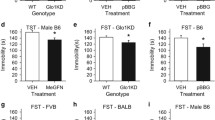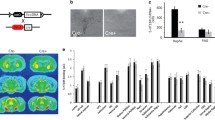Abstract
Rationale
Galanin and its receptors exert inhibitory neuromodulatory control over brain monoamines. Rat studies revealed that galanin expression is upregulated by exposure to stressors and that galanin manipulations modify neuroendocrine and behavioral responses to stress, leading to the hypothesis that galanin mediates depression-related behaviors.
Methods
In the present study, we examined the role of galanin in modulating antidepressant-related behavior in galanin overexpressing transgenic (GAL-tg) mice and galanin receptor R1 knockout (GAL-R1 KO) mice, using the tail suspension test (TST). Quantitative autoradiography for 5-HT1A-R and serotonin transporter binding density tested for changes in these two major regulatory components of the 5-HT system in galanin mutant mice.
Results
Baseline TST behavior was normal in GAL-tg and GAL-R1 KO mice, and intracerebroventricular administration of galanin failed to alter TST behavior in normal C57BL/6J mice. The TST anti-immobility effects of acute treatment with the serotonin reuptake inhibitor, fluoxetine (0–30 mg/kg), and the norepinephrine reuptake inhibitor, desipramine (0–30 mg/kg), were unaltered in galanin mutant mice. Hippocampal 5-HT1A-R density was significantly elevated in GAL-tg and GAL-R1 KO mice, while hippocampal 5-HTT density was reduced in GAL-R1 KO mice, relative to controls.
Conclusion
Neither pharmacological nor molecular genetic manipulations of galanin altered depression-related profiles in the TST. Possible functional alterations in hippocampal 5-HT neurotransmission may have contributed to these negative results. These preliminary findings provide evidence against the hypothesis that galanin plays a central role in mouse depression-related behaviors. It remains possible that galanin modulates depression-related responses in other experimental paradigms and species.




Similar content being viewed by others
References
Bartfai T, Lu X, Badie-Mahdavi H, Barr AM, Mazarati A, Hua XY, Yaksh T, Haberhauer G, Ceide SC, Trembleau L et al. (2004) Galmic, a nonpeptide galanin receptor agonist, affects behaviors in seizure, pain, and forced-swim tests. Proc Natl Acad Sci USA 101:10470–10475.
Bellido I, Diaz-Cabiale Z, Jimenez-Vasquez PA, Andbjer B, Mathe AA, Fuxe K (2002) Increased density of galanin binding sites in the dorsal raphe in a genetic rat model of depression. Neurosci Lett 317:101–105
Bing O, Moller C, Engel JA, Soderpalm B, Heilig M (1993) Anxiolytic-like action of centrally administered galanin. Neurosci Lett 164:17–20
Blier P, Ward NM (2003) Is there a role for 5-HT1A agonists in the treatment of depression? Biol Psychiatry 53:193–203
Branchek TA, Smith KE, Gerald C, Walker MW (2000) Galanin receptor subtypes. Trends Pharmacol Sci 21:109–117
Cheung CC, Hohmann JG, Clifton DK, Steiner RA (2001) Distribution of galanin messenger RNA-expressing cells in murine brain and their regulation by leptin in regions of the hypothalamus. Neuroscience 103:423–432
Consolo S, Baldi G, Russi G, Civenni G, Bartfai T, Vezzani A (1994) Impulse flow dependency of galanin release in vivo in the rat ventral hippocampus. Proc Natl Acad Sci USA 91:8047–8051
Crawley JN (2000) What’s wrong with my mouse? Behavioral phenotyping of transgenic and knockout mice. Wiley-Liss, New York
Crawley JN, Belknap JK, Collins A, Crabbe JC, Frankel W, Henderson N, Hitzemann RJ, Maxson SC, Miner LL, Silva AJ, Wehner JM, Wynshaw-Boris A, Paylor R (1997) Behavioral phenotypes of inbred mouse strains: implications and recommendations for molecular studies. Psychopharmacology 132:107–124
Crawley JN, Mufson EJ, Hohmann JG, Teklemichael D, Steiner RA, Holmberg K, Xu ZQ, Blakeman KH, Xu XJ, Wiesenfeld-Hallin Z, Bartfai T, Hokfelt T (2002) Galanin overexpressing transgenic mice. Neuropeptides 36:145–156
Cryan JF, Mombereau C (2004) In search of a depressed mouse: utility of models for studying depression-related behavior in genetically modified mice. Mol Psychiatry 9(4):326–357
Franklin KBJ, Paxinos G (1997) The mouse brain in stereotaxic coordinates. Academic, San Diego
Fuxe K, Jansson A, Diaz-Cabiale Z, Andersson A, Tinner B, Finnman UB, Misane I, Razani H, Wang FH, Agnati LF, Ögren SO (1998) Galanin modulates 5-hydroxytryptamine functions. Focus on galanin and galanin fragment/5-hydroxytryptamine1A receptor interactions in the brain. Ann N Y Acad Sci 863:274–290
Gross C, Zhuang X, Stark K, Ramboz S, Oosting R, Kirby L, Santarelli L, Beck S, Hen R (2002) Serotonin1A receptor acts during development to establish normal anxiety-like behaviour in the adult. Nature 416:396–400
Hohmann JG, Jureus A, Teklemichael DN, Matsumoto AM, Clifton DK, Steiner RA (2003) Distribution and regulation of galanin receptor 1 messenger RNA in the forebrain of wild type and galanin-transgenic mice. Neuroscience 117:105–117
Holets VR, Hökfelt T, Rokaeus A, Terenius L, Goldstein M (1988) Locus coeruleus neurons in the rat containing neuropeptide Y, tyrosine hydroxylase or galanin and their efferent projections to the spinal cord, cerebral cortex and hypothalamus. Neuroscience 24:893–906
Holmes A, Yang RJ, Crawley JN (2002a) Evaluation of an anxiety-related phenotype in galanin overexpressing transgenic mice. J Mol Neurosci 18:151–165
Holmes A, Yang RJ, Murphy DL, Crawley JN (2002b) Evaluation of antidepressant-related behavioral responses in mice lacking the serotonin transporter. Neuropsychopharmacology 27:914–923
Holmes A, Heilig M, Rupniak NM, Steckler T, Griebel G (2003a) Neuropeptide systems as novel therapeutic targets for depression and anxiety disorders. Trends Pharmacol Sci 24:580–588
Holmes A, Kinney JW, Wrenn CC, Li Q, Yang RJ, Ma L, Vishwanath J, Saavedra MC, Innerfield CE, Jacoby AS, Shine J, Iismaa TP, Crawley JN (2003b) Galanin GAL-R1 receptor null mutant mice display increased anxiety-like behavior specific to the elevated plus-maze. Neuropsychopharmacology 28:1031–1044
Holmes A, Li Q, Murphy DL, Gold E, Crawley JN (2003c) Abnormal anxiety-related behavior in serotonin transporter null mutant mice: the influence of genetic background. Genes Brain Behav 2:365–380
Hökfelt T, Millhorn D, Seroogy K, Tsuruo Y, Ceccatelli S, Lindh B, Meister B, Melander T, Schalling M, Bartfai T et al. (1987) Coexistence of peptides with classical neurotransmitters. Experientia 43:768–780
Hökfelt T, Bartfai T, Crawley JN (1998a) Galanin: basic research discoveries and therapeutic implications. New York Academy of Sciences, New York
Hökfelt T, Xu ZQ, Shi TJ, Holmberg K, Zhang X (1998b) Galanin in ascending systems. Focus on coexistence with 5-hydroxytryptamine and noradrenaline. Ann N Y Acad Sci 863:252–263
Jacoby AS, Hort YJ, Constantinescu G, Shine J, Iismaa TP (2002) Critical role for GALR1 galanin receptor in galanin regulation of neuroendocrine function and seizure activity. Brain Res Mol Brain Res 107:195–200
Kehr J, Yoshitake T, Wang FH, Wynick D, Holmberg K, Lendahl U, Bartfai T, Yamaguchi M, Hökfelt T, Ögren SO (2001) Microdialysis in freely moving mice: determination of acetylcholine, serotonin and noradrenaline release in galanin transgenic mice. J Neurosci Methods 109:71–80
Kehr J, Yoshitake T, Wang FH, Razani H, Gimenez-Llort L, Jansson A, Yamaguchi M, Ögren SO (2002) Galanin is a potent in vivo modulator of mesencephalic serotonergic neurotransmission. Neuropsychopharmacology 27:341–356
Khoshbouei H, Cecchi M, Dove S, Javors M, Morilak DA (2002) Behavioral reactivity to stress: amplification of stress-induced noradrenergic activation elicits a galanin-mediated anxiolytic effect in central amygdala. Pharmacol Biochem Behav 71:407–417
Larm JA, Shen PJ, Gundlach AL (2003) Differential galanin receptor-1 and galanin expression by 5-HT neurons in dorsal raphe nucleus of rat and mouse: evidence for species-dependent modulation of serotonin transmission. Eur J Neurosci 17:481–493
Ma X, Tong YG, Schmidt R, Brown W, Payza K, Hodzic L, Pou C, Godbout C, Hökfelt T, Xu ZQ (2001) Effects of galanin receptor agonists on locus coeruleus neurons. Brain Res 919:169–174
Misane I, Razani H, Wang FH, Jansson A, Fuxe K, Ögren SO (1998) Intraventricular galanin modulates a 5-HT1A receptor-mediated behavioural response in the rat. Eur J Neurosci 10:1230–1240
Moller C, Sommer W, Thorsell A, Heilig M (1999) Anxiogenic-like action of galanin after intra-amygdala administration in the rat. Neuropsychopharmacology 21:507–512
Perez SE, Wynick D, Steiner RA, Mufson EJ (2001) Distribution of galaninergic immunoreactivity in the brain of the mouse. J Comp Neurol 434:158–185
Pieribone VA, Xu ZQ, Zhang X, Grillner S, Bartfai T, Hökfelt T (1995) Galanin induces a hyperpolarization of norepinephrine-containing locus coeruleus neurons in the brainstem slice. Neuroscience 64:861–874
Razani H, Diaz-Cabiale Z, Fuxe K, Ögren SO (2000) Intraventricular galanin produces a time-dependent modulation of 5-HT1A receptors in the dorsal raphe of the rat. Neuroreport 11:3943–3948
Steiner RA, Hohmann JG, Holmes A, Wrenn CC, Cadd G, Jureus A, Clifton DK, Luo M, Gutshall M, Ma SY, Mufson EJ, Crawley JN (2001) Galanin transgenic mice display cognitive and neurochemical deficits characteristic of Alzheimer’s disease. Proc Natl Acad Sci USA 98:4184–4189
Weiss JM, Bonsall RW, Demetrikopoulos MK, Emery MS, West CH (1998) Galanin: a significant role in depression? Ann N Y Acad Sci 863:364–382
Wrenn CC, Crawley JN (2001) Pharmacological evidence supporting a role for galanin in cognition and affect. Prog Neuropsychopharmacol Biol Psychiatry 25:283–299
Wrenn CC, Marriott LK, Kinney JW, Holmes A, Wenk GL, Crawley JN (2002) Galanin peptide levels in hippocampus and cortex of galanin-overexpressing transgenic mice evaluated for cognitive performance. Neuropeptides 36:413–426
Wrenn CC, Kinney JW, Marriott LK, Holmes A, Harris AP, Saavedra MC, Starosta G, Innerfield CE, Jacoby AS, Shine J, Iismaa TP, Wenk GL, Crawley JN (2004) Learning and memory performance in mice lacking the GAL-R1 subtype of galanin receptor. Eur J Neurosci 19:1384–1396
Xu ZQ, Shi TJ, Hökfelt T (1998a) Galanin/GMAP- and NPY-like immunoreactivities in locus coeruleus and noradrenergic nerve terminals in the hippocampal formation and cortex with notes on the galanin-R1 and -R2 receptors. J Comp Neurol 392:227–251
Xu ZQ, Zhang X, Pieribone VA, Grillner S, Hökfelt T (1998b) Galanin-5-hydroxytryptamine interactions: electrophysiological, immunohistochemical and in situ hybridization studies on rat dorsal raphe neurons with a note on galanin R1 and R2 receptors. Neuroscience 87:79–94
Yoshitake T, Reenila I, Ögren SO, Hökfelt T, Kehr J (2003) Galanin attenuates basal and antidepressant drug-induced increase of extracellular serotonin and noradrenaline levels in the rat hippocampus. Neurosci Lett 339:239–242
Yoshitake T, Wang FH, Kuteeva E, Holmberg K, Yamaguchi M, Crawley JN, Steiner R, Bartfai T, Ögren SO, Hökfelt T, Kehr J (2004) Enhanced hippocampal noradrenaline and serotonin release in galanin-overexpressing mice after repeated forced swimming test. Proc Natl Acad Sci USA 101:354–359
Zachariou V, Brunzell DH, Hawes J, Stedman DR, Bartfai T, Steiner RA, Wynick D, Langel U, Picciotto MR (2003) The neuropeptide galanin modulates behavioral and neurochemical signs of opiate withdrawal. Proc Natl Acad Sci USA 100:9028–9033
Acknowledgements
This study was supported by the NIMH Intramural Research Program. We sincerely thank R.A. Steiner for the generous provision of GAL-tg mice for breeding, T.P. Iismaa and J. Shine for the generous provision of GAL-R1 KO mice for breeding and C.C. Wrenn for help with surgical procedures.
Author information
Authors and Affiliations
Corresponding author
Rights and permissions
About this article
Cite this article
Holmes, A., Li, Q., Koenig, E.A. et al. Phenotypic assessment of galanin overexpressing and galanin receptor R1 knockout mice in the tail suspension test for depression-related behavior. Psychopharmacology 178, 276–285 (2005). https://doi.org/10.1007/s00213-004-1997-1
Received:
Accepted:
Published:
Issue Date:
DOI: https://doi.org/10.1007/s00213-004-1997-1




